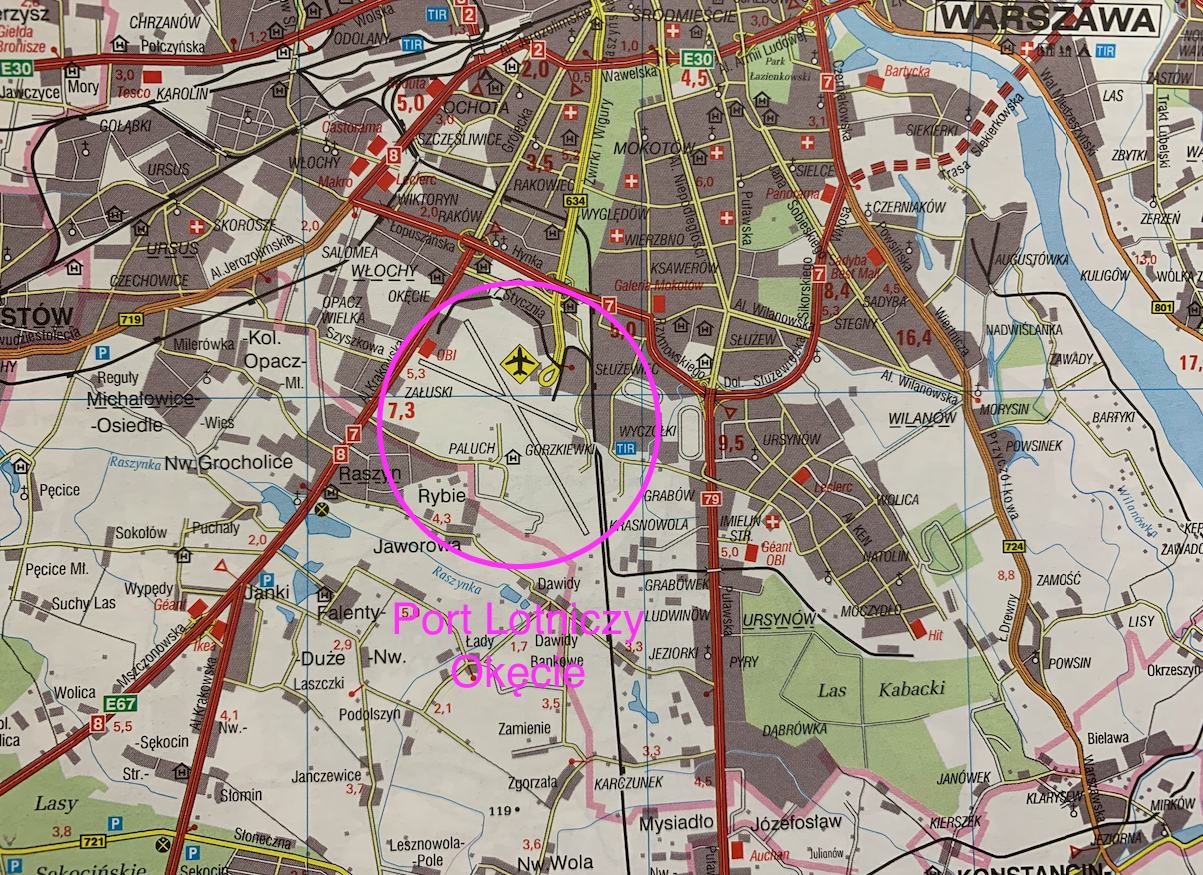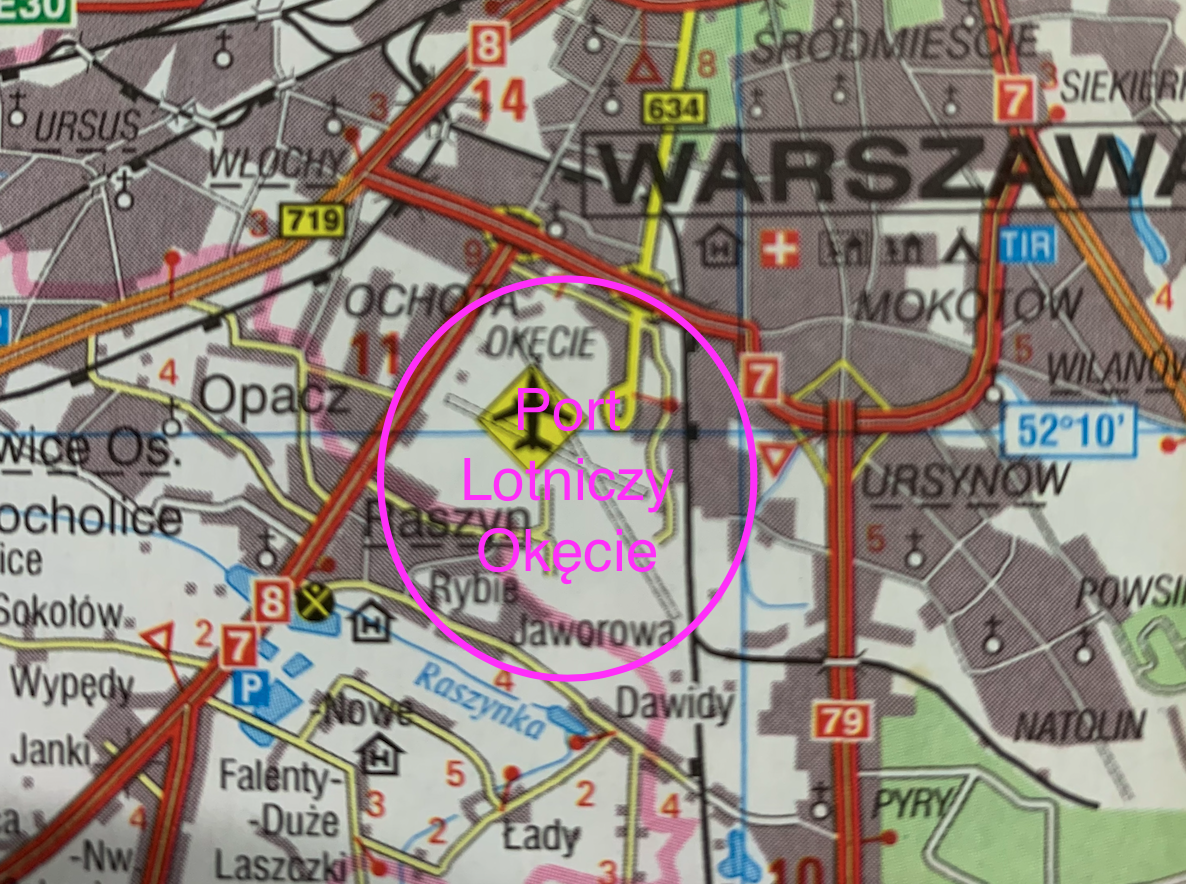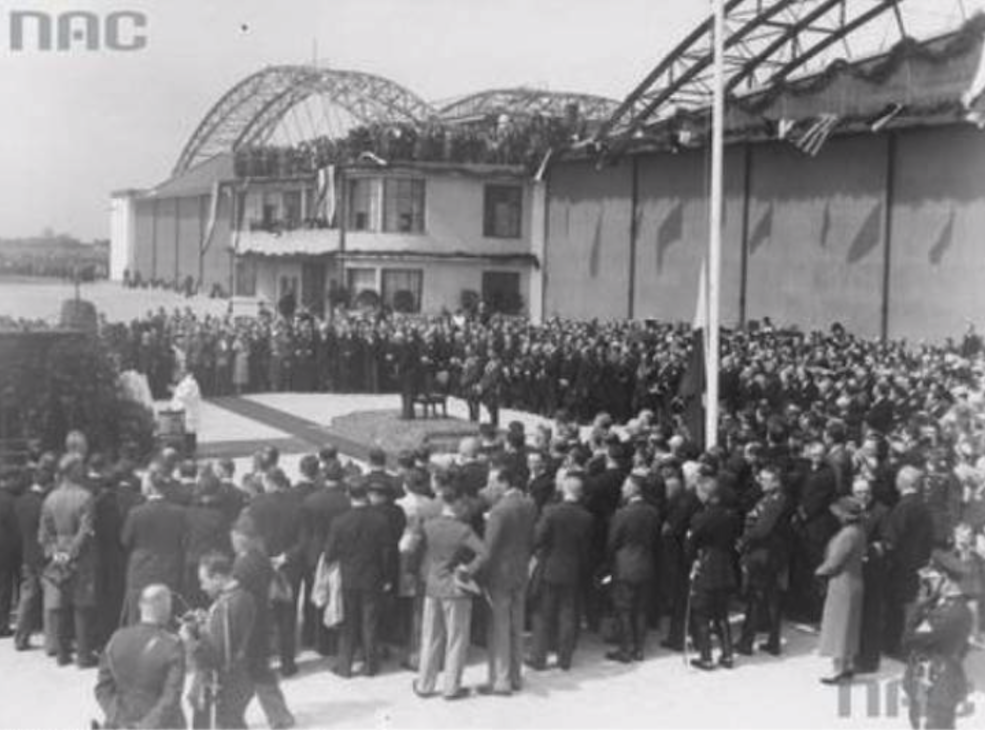Warszawa 2009-12-03
Okęcie airport in Warsaw.
The history of the Okęcie settlement.
Currently (2009) a district of Warsaw called Okecie is associated with an airport. But the history of Okęcie dates back to medieval times, when a settlement belonging to the parish of Służew was established here. It was inhabited by the nobility of Wierzbowa and Prus coat of arms. Then, for a long time, it became the property of the Okęcki family. Hence the later name. Its area was about 2 lans larger. (1 bigger fief = 48 morg = 24.2 hectares). Then the property passed through successive families. In the 17th century, it belonged to Petrykowski, and in the 18th century to General Byszewski, who also owned the neighboring Załuski, Opacz and part of Raków. Through today’s Okęcie ran the Radom Route, which was destroyed during the Swedish invasions. Its reconstruction began after 1720. In 1789. Okęcie had 26 farms. In the 19th century, a large estate was established, including Okęcie, Raków and Marcinkówka. The owners of this estate were the Łabędzki family. The buildings of the manor farm were located at the present 17 Stycznia Street. In 1856, the owners built a palace according to the design of Bolesław Orłowski. Administratively, in this period, these areas belonged to the Pruszków commune. At that time, Trakt Krakowski and defensive forts were built.
In May 1789, the first Pole took to the air over Warsaw. The hot air balloon flight was performed by Jan Nepomucen Potocki. The flight lasted one hour.
The first Warsaw heliport is a horse racing track at Polna Street, later transformed into the Mokotowskie Airport. The horse racing area was called during the tsarist occupation, officially – the city for a horse jumper. It was located on the western side of today’s Polna Street. And there, in 1909, the people of Warsaw saw the first plane. On September 17, 1909, the Frenchman Mr. Legagneux made the first motorized flight lasting about 2 minutes.
A year later, the Aviator Circle was founded, using the Race Grounds. Then the ascents also took place from the lawns running where Trasa Łazienkowska runs today.
On August 13, 1911, the first airplane flight to the capital was made by Michał Scipio del Campo, a Pole with an Italian surname. The flight lasted about 17 minutes and ran along Polna Street, then Marszałkowska Street, turned back over Plac Zamkowy and returned to the starting point along the same route. The next day, on August 14, 1911, the second Pole, Mr. Jankowski, made a flight in his plane, rising to a height of 1,200 m, which is twice as high as Michał Scipio del Campo. The flight was planned for August 13, 1911, but then the engine failed. The flights of the Poles were vividly described in the daily press. Journalists used terms; "circled the airfield, soared over the airfield." Thus the press assumed that the grounds of the Horse Racing had become an airport. From 1912, more and more flights were made, and the area of the landing site in Pola was expanding.
The next stage of development of the airport in Pole Mokotowskie took place during the World War. From 1915, this area was occupied by the Germans.
Okęcie airport.
The biggest changes for Okęcie took place after the Republic of Poland regained its independence in 1918, when Okęcie was included in the spatial plan of the city of Warsaw. At that time, these areas were subordinated to the Skorosze Commune. Interestingly, it was already realized at that time that the Mokotów Airport would hinder the development of Warsaw towards the south, and the councilors responsible for the city planned three airports in the future – a military airport in Okęcie, a sports airport in Bielany (in the area of today’s Wrzecion) and a large passenger airport in Gocław. However, after World War II, a huge military airport was built in today’s Bemowo/Bernerowo.
Until the beginning of the 1930s, the Mokotowskie Airport was operating at its best and, despite later relocations, planes still landed there. An interesting fact is that until 1947, planes, mainly military ones, landed here.
In 1923, a railway and a tram line were brought to Okęcie. The construction of the airport at Okęcie began in 1924. An area of 456 hectares was purchased for the purpose of the new airport. In 1929, the PZL Engine Factory and Civil Aircraft Repair Workshops were established here. In 1929, several combat squadrons were transferred to Okęcie Airport.
In the period of 1933-1934, air traffic was transferred from Pole Mokotowskie Airport to Okęcie. At that time, a road from Śródmieście to the Okęcie airport was built. This is today’s Al. Żwirki i Wigury.
Since 1933, the Okęcie area has become a center of aviation-related industry, where over 7,500 people worked in the 1930s. It must be remembered that the Okęcie district was still an agricultural area that provided food for the city.
On April 29, 1934, the airport was officially opened at Okęcie Airport. There was President Ignacy Mościcki, Prime Minister Janusz Jędrzejewski, Speaker of the Sejm, five ministers, a diplomatic corps with the ambassadors of the United States, CCCP and Italy, and directors of seven European airlines. The Holy Mass was celebrated by the field bishop, Father Józef Gawlina.
Grand opening of Okęcie Airport. Field Holy Mass celebrated by the field bishop Józef Gawlin. President Ignacy Mościcki in the place of honor. April 29, 1934. In the first row, from the left, sitting from the right: Prime Minister Janusz Jędrzejewicz, Speaker of the Sejm Kazimierz Świtalski, Governor of Warsaw Stanisław Twardo, Minister of the Interior Bronisław Pieracki, Governor of Warsaw Władysław Jaroszewicz, Minister of the Treasury Władysław Marian Zawadzki, Minister of Labor and Social Welfare Stefan Hubicki, Minister communication Michał Butkiewicz, Minister of Post and Telegraphs Emil Kaliński, Deputy Minister of Foreign Affairs Jan Szembek. On the right side sat representatives of diplomacy.
The airport at Okęcie Airport was modern. Between the hangars were two stylish buildings. One was the train station, the other the airport service.
A 50-meter-high tower with an airport beacon, visible within a radius of 100 kilometers, rose above the terrain. This is how navigational problems were solved then. Thanks to this beacon, the pilots had easier orientation. It functioned on the same principle as lighthouses. There were no radar stations at that time.
Since the opening of Okęcie Airport, the development has been rapid. In 1935, the Okęcie airport served about 11,000 passengers. Modern aircraft appeared; Douglas DC-2, Lockheed L-14 Super Elektra and others. In 1936, the first Polish civil transport pilot flew 1,000,000 kilometers. At that time, the hours spent in the air were not counted, only the actual distances covered. In the group of millionaires were; Kazimierz Burzyński, Klemens Długoszewski and Tadeusz Karpiński. By August 1939, several more pilots had achieved this result.
In 1937, the Lorentz system beacons were installed at the airport, which helped pilots to locate the airport in difficult weather conditions.
On April 1, 1938, Okęcie became a separate administrative and economic unit called the Okęcie Commune.In the summer of 1939, great celebrations related to the 10th anniversary of PLL LOT were held at Okęcie Airport.
The Second World War.
From September 1, 1939, the German army systematically destroyed the Republic of Poland and Warsaw. The occupant caused the greatest havoc at Okęcie Airport. Were destroyed; landing field, harbor building and hangars. Tram tracks and streets were damaged.
After losing the defensive war, the Germans began to rebuild what they had destroyed. By the hands of the prisoners, of course. During the occupation of the Republic of Poland, Okęcie was one of the most important air bases of the German army. At that time, the first paved runway was built.
When the eastern front was approaching, the Germans, afraid of an enemy landing on their back, decided to destroy the airport. They blew up the runway with buried bombs and dug ditches deep into the rest of the area. In aerial photographs taken on September 17, 1944, the landing field looks like Swiss cheese. During the Warsaw Uprising, one of the damaged Liberators, bringing help to Warsaw residents, landed at the destroyed Okęcie airport. The second such plane, also damaged, landed on the wasteland of today’s Bemowo Airport.
As already mentioned, during the Second Polish Republic, it was decided to build two more airports; in Bielany and Gocław. The first one, also called Młociński, did not go beyond the phase of a grassy area with a hardened landing field. During the occupation, the German army expanded it a bit, but it was still just a landing site without buildings. Polish attacks began at the beginning of the Warsaw Uprising and were extremely bloody. One of the Home Army soldiers from the Kampinos Group recalled the second attack in a row: “Artillery fire is raging. I see the retreat of our tirailleur (…). The battalion suffered significant casualties." We did not capture Bielany, but the Luftwaffe was so afraid of losing the area that it destroyed it already in August 1944. The airport was located at the height of the Italian cemetery, on the left side of the Gdańsk road leaving the city. After the war, this area was abandoned as an aviation area and then used as a housing estate. Today, the Wrzeciona housing estate and part of Huta Warszawa are located there.
The second, undeveloped airport was located in Gocław – interestingly – the course of the streets – the transverse Bora-Komorowskiego and the circumferential route of Abraham and Meissner – reproduces the planned and partly built runways. But after 1976, only remnants of buildings remained in the form of hangars on the side of Wał Miedzeszyński. This is history and is described in a separate chapter.
Bemowo Airport also called Babice or Boernerowo Airport. This is history and is described in a separate chapter.
Written by Karol Placha Hetman




